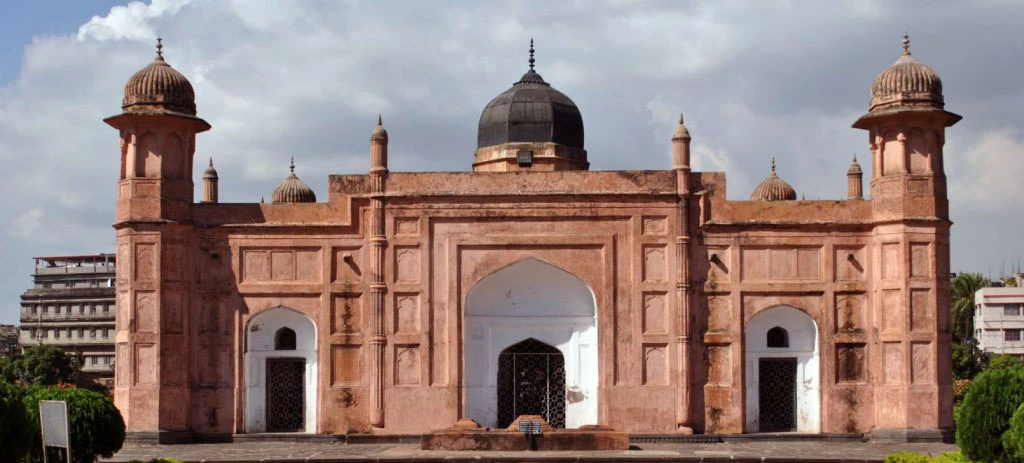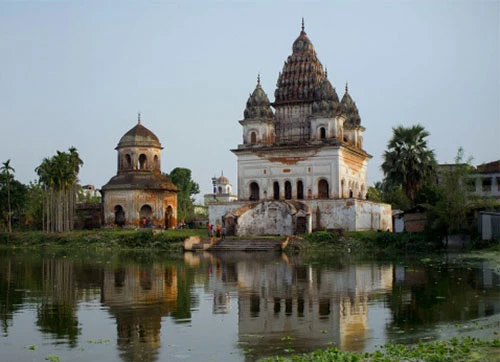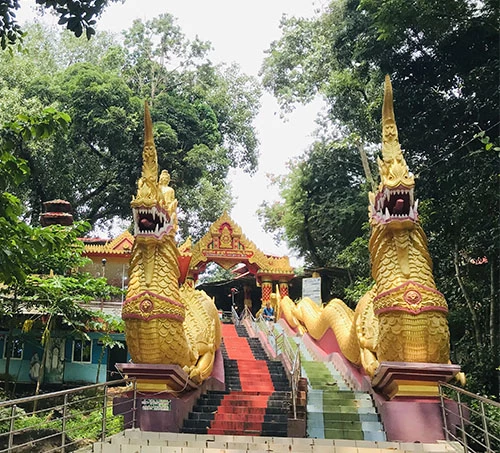Bangladesh is a country located in South Asia, situated on the Bay of Bengal. The country is almost surrounded by neighboring India and shares a small border with Myanmar to its southeast. Although it lies very close to Nepal, Bhutan, and China. The country is divided into three regions. The largest region is the fertile Ganges Delta, which is the largest river delta in the world and dominates most of the country. The northwest and central parts of the country are formed by the Madhupur and the Barind plateaus. The northeast and southeast regions are home to evergreen hill ranges.
Bangladesh is mostly flat and fertile land. The majority of its terrain is less than 12 meters (39 feet) above sea level, and it is estimated that a 1-meter (3.3 feet) rise in sea level would result in about 10% of the country's land area being flooded. Around 17% of the land is covered by forests, and the country has a 12% coverage of hilly areas. The Haor wetlands in Bangladesh are of great significance to global environmental science. The highest point in Bangladesh is Saka Haphong, situated near the Myanmar border, with an elevation of 1064 meters (3491 feet).
Climate:
Straddling Bangladesh’s climate is tropical, with a mild winter from October to March and a hot, humid summer from March to June. The country has never recorded an air temperature below 0 °C (32 °F) with a record low of 1.1 °C (34 °F) in the northwest city of Dinaipur on 3 February 1905. A warm and humid monsoon season lasts from June to October and supplies most of the country's rainfall.
Tourism In Bangladesh;
The tourism industry is growing and currently contributes around 3.02% of the total GDP of Bangladesh. In 2019, Bangladesh earned $391 million from international tourism receipts. The country is home to three UNESCO World Heritage sites, namely The Mosque City, The Paharpur Buddhist Ruins, and the Sundarbans, as well as several other tentative list sites along the river.
Tourists visiting Bangladesh can enjoy a range of activities such as angling, water skiing, river cruising, hiking, rowing, yachting, and beachgoing. According to the World Travel and Tourism Council's 2019 report, the travel and tourism industry directly generated 1,180,500 jobs in 2018, which accounts for 1.9% of the country's total employment. The same report states that Bangladesh receives around 125000 international tourist arrivals per year.
Most Popular Place to Visit in Bangladesh;
Sundarban Forest:
The Sundarban is the largest contiguous mangrove forest in the world covering over 10000 square kilometers of wilderness. This forest is considered the richest mangrove forest in the world in terms of species diversity and is not only home to the critically endangered Royal Bengal tiger but also other threatened wild species.
In 1999 the Sundarban became under UNESCO World Heritage Site. Recently a study from the Wildlife Conservation Society identified three areas in the Sundarban mangrove forest as dolphin hotspots and the areas were declared as wildlife sanctuaries for the conservation of threatened freshwater dolphins in 2012.
Somapura Vihara:
By far the most Spectacular Buddhist monument discovered in regular excavation is the gigantic temple and monastery. Archeologically and historically SomapuraVihara of Paharpur is a UNESCO heritage of the world. The remains of the most important & the largest known monastery south of Himalaya, built between the 7th century and the 3rd part of the 8th century. UNESCO World heritage site.
Mohasthangarh :
Mohasthangarh is invariably an ancient fortified city acclaimed to be the oldest settlement and the most prominent archaeological site in Bangladesh. The oldest layer dates back to the 4th century B.C. The ancient Pundranagara, the Capital of Hindu Emperor Chandragupta, was the founder of the Moyura Dynasty on the bank of the river Karatoya.
ShawrupkathiBackwater Trip:
A backwater trip at Shawrupkathi will explore floating vegetable gardens on the river, the floating beds. The vegetation on the banks and many interesting activities of the locals are based on the river. Boats are full of seasonal fruits like Guava, Lemon, Hog-Plam, etc. while you will be exploring the backwater.
Varendra Research Museum:
Varendra Museum was the first museum to be established in erstwhile East Bengal in 1910. The museum started as the collection of the Varendra Investigation Society and got its current name in 1919. Since its inception, this museum has actively searched & researched the history of the ancient Varendra Civilization. Excavation at Somapura Bihara was started by the society along with Calcutta University in 1923. In 1964, the museum became a part of Rajshahi University. The museum has a very rich collection of ancient stuff from different parts of Bangladesh.
Sreemangal:
Known as the “Tea Capital of Bangladesh” The panoramic tea gardens are nestled in lush green valleys, scented herbal plants, orange, groves, and pineapple plantations. The hilltop tribal villages of Monipuri, Tripura, Khasia, and Garo communities with their own culture and heritage, are a great surprise. Some of the World’s largest tea gardens are located at Sreemangal.
Lawachhara National Park:
This is a reserved rainforest located about 12 km from Sreemangal Town. The forest has numerous and rare species of trees like Chloroform, White Sandal, and Agar along with wonderful scenic splendors with rich flora and fauna. The forest has an area of 4,750 hectares of land and was declared a National Park in 1997.
National Parliament House:
National Parliament House, is the house of the Parliament of Bangladesh, located at Sher-e-Bangla Nagar in the Bangladeshi capital of Dhaka. Designed by architect Louis Kahn in 1961 & completed the construction works on 1081, the complex is one of the largest legislative complexes in the world, comprising 200 acres.
Lalbagh Fort Dhaka;
During the Mughal period, Emperor Aurangzeb appointed his 3rd son Prince MD. Azam as Subedero (Provincial Governor) of Bengal on 29 July 1678. Prince Azam started construction of this fort and named it after his father Killa Aurangabad. Before completion LALBAGH fort his father called him a Subeder and to complete the fort. However, due to the death daughter of Shaista Khan Iran Dukht was nicknamed as Paribibi or fairy lady in 1684. Shaista Khan stopped its construction making the fort. After Shaista Khan started construction making the fort his daughter named as tomb of Paribibi. Other attractions are the audience hall, mosque, and Hammam of Shaista Khan.
Curzon Hall:
Curzon Hall, the best example of Dhaka's architecture. It is part of the School of Science of the University of Dhaka. It's 100 years (1905) old. Build by the British for the purpose of a Town hall, but it has never been used as a Town Hall. Curzon Hall has an extremely fascinating history which is situated beside High Court Street, Dhaka. Now it has become the base of the university's science faculty.
Dhakeshwari National Temple:
Dhakeshwari is the central Hindu temple in Dhaka, Bangladesh. It is state-owned, giving it the distinction of being Bangladesh's Every year in September (exact dates vary according to the Hindu calendar), the temple and surrounding streets throng with thousands of celebrants for Durga Puja, the goddess' annual festival, a particular colorful, noisy and joyful time to visit.
Kusumba Mosque:
Kusumba mosque is named after the village of Kusumba. It was built during the period of Afgan rule in Bangladesh by a high-ranking official named Sulaiman. It was built under one of the last Suri rulers. His name was GhiyasuddinBahadur Shah. Although the mosque was built under the Suri rule, the architectural pattern was not influenced by the earlier Suri architecture of North India. It was constructed with a Bengal style. At the eastern central entrance, the inscription mentioned the time period of construction of the mosque as 966 AH (1558-59 AD).
Panam City at Sonargaon Narayanganj;
The old capitals of Bengal, situated near the eastern peripheral land of Dhaka at about 27 km distance from the zero Point, the site represents the substantial remains of an early medieval bygone city called Sonargaon. It now accommodates a mosque called Gowaldi Masjid built in stone–brick masonry (1519 AD), a tomb built entirely of carved stone called Sultan GiasuddinAzam Shah Mazar, a bridge (17th cent AD), a tomb complex, and some sparse structural vestiges. There is also a folk museum at one corner of the site. Another attraction of the site is an early modern settlement called Panam City.
Tangail (Rural Culture):
Tangail, located (100 km from Dhaka) in the central region of Bangladesh on the banks of the Louhajang River, is part of the Dhaka Division. Experience Jacquard weaving in this village. KartikBashak- the master artisan of Jacquard. Center of multi-dimensional activities like traditional seed-keeping system.
Feel the real taste of the rural culture of Bangladesh, experience how the hardworking people here manufacture sunflower oil, break rice with husking-pedal ‘Dheki’ by the foot, make puffed rice ‘Muri’ by heating sand in a clay pot and then throw the grains of rice in them, compose fertilizer for organic crops & vegetable cultivation making and many more. Muŗi, Khai, and other rice items such as” Pitha”, and “Chira” are very popular &used in a wide variety of secular and religious occasions or even just munched (Crispi) plain. Other attractions are Buti weaving, silversmith, cultivation of organic food, etc.



